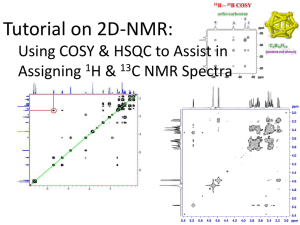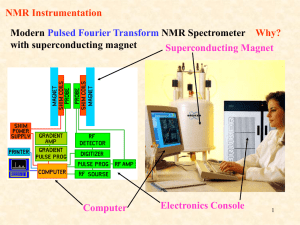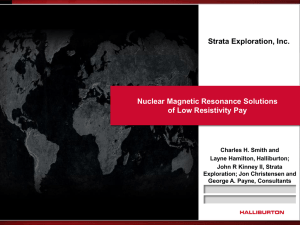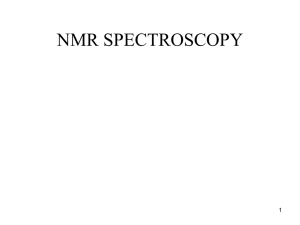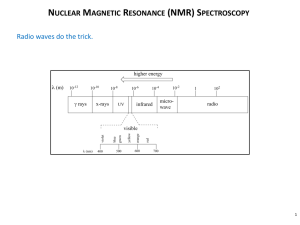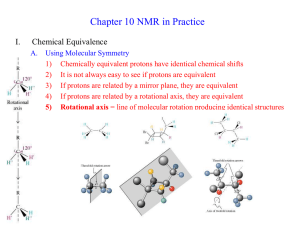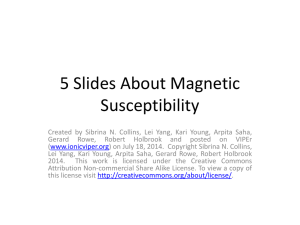Chapter 1: Introduction to NMR Theory
advertisement
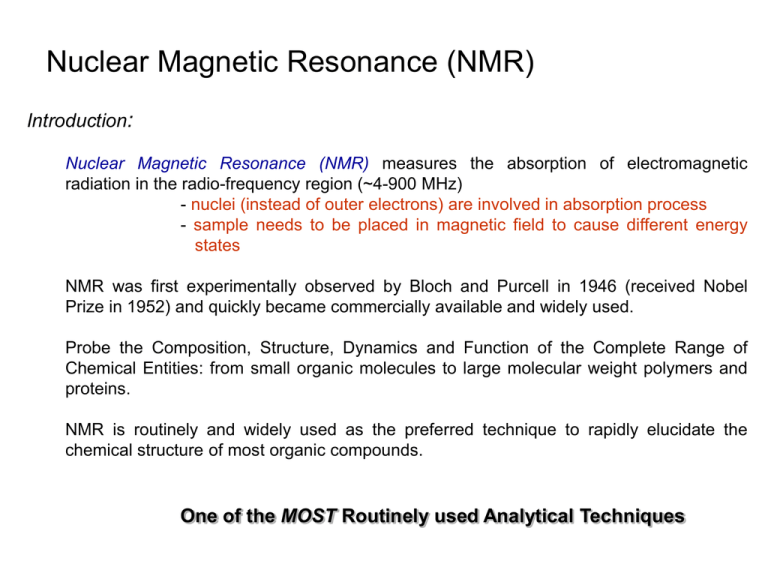
Nuclear Magnetic Resonance (NMR) Introduction: Nuclear Magnetic Resonance (NMR) measures the absorption of electromagnetic radiation in the radio-frequency region (~4-900 MHz) - nuclei (instead of outer electrons) are involved in absorption process - sample needs to be placed in magnetic field to cause different energy states NMR was first experimentally observed by Bloch and Purcell in 1946 (received Nobel Prize in 1952) and quickly became commercially available and widely used. Probe the Composition, Structure, Dynamics and Function of the Complete Range of Chemical Entities: from small organic molecules to large molecular weight polymers and proteins. NMR is routinely and widely used as the preferred technique to rapidly elucidate the chemical structure of most organic compounds. One of the MOST Routinely used Analytical Techniques O Typical Applications of NMR: 1.) Structural (chemical) elucidation Natural product chemistry Synthetic organic chemistry - analytical tool of choice of synthetic chemists - used in conjunction with MS and IR 2.) Study of dynamic processes reaction kinetics study of equilibrium (chemical or structural) 3.) Structural (three-dimensional) studies Proteins, Protein-ligand complexes DNA, RNA, Protein/DNA complexes Polysaccharides 4.) Metabolomics 5.) Drug Design Structure Activity Relationships by NMR 6.) Medicine -MRI MRI images of the Human Brain O O NH O O OH O OH HO O O O O O Taxol (natural product) NMR Structure of MMP-13 complexed to a ligand NMR History 1937 1946 1953 1966 1975 1984 1985 Rabi predicts and observes nuclear magnetic resonance Bloch, Purcell first nuclear magnetic resonance of bulk sample Overhauser NOE (nuclear Overhauser effect) Ernst, Anderson Fourier transform NMR Jeener, Ernst 2D NMR Nicholson NMR metabolomics Wüthrich first solution structure of a small protein (BPTI) from NOE derived distance restraints 1987 3D NMR + 13C, 15N isotope labeling of recombinant proteins (resolution) 1990 pulsed field gradients (artifact suppression) 1996/7 residual dipolar couplings (RDC) from partial alignment in liquid crystalline media TROSY (molecular weight > 100 kDa) 2000s Dynamic nuclear polarisation (DNP) to enhance NMR sensitivity Nobel prizes 1944 Physics Rabi (Columbia) 1952 Physics Bloch (Stanford), Purcell (Harvard) 1991 Chemistry Ernst (ETH) 2002 Chemistry Wüthrich (ETH) 2003 Medicine Lauterbur (University of Illinois in Urbana ), Mansfield (University of Nottingham) NMR History First NMR Spectra on Water 1H NMR spectra of water Bloch, F.; Hansen, W. W.; Packard, M. The nuclear induction experiment. Physical Review (1946), 70 474-85. NMR History First Observation of the Chemical Shift 1H NMR spectra ethanol Modern ethanol spectra Arnold, J.T., S.S. Dharmatti, and M.E. Packard, J. Chem. Phys., 1951. 19: p. 507. Bloch Equations Net Magnetization (M) placed in a magnetic Field (B) will precess: and relax (R) and relax individual components: Course Goals • We will NOT Cover a Detailed Analysis of NMR Theory • We will NOT Derive the Bloch Equations • We will NOT Discuss, in detail, a Quantum Mechanical Description of NMR • We will NOT use Product Operator Formulism to Describe NMR Experiments • If Interested, Dr. Harbison will Cover These Topics in a Separate Special Topics Course • We Will Discuss Practical Aspects of Using an NMR • We Will Take a Conceptual Approach to Understanding NMR • A Focus of the Course will be the Application of NMR to Solving the Structure of Organic Molecules • We Will Discuss the Basic Operations of an NMR Spectrometer. • We Will Discuss the Proper Approaches to the Set-up, Process and Analysis of NMR Experiments • We Will Use NMR to Solve the Structure of Unknowns • The Goal is to Not Treat an NMR Spectrometer as a Black Box, but to be a Competent Experimentalist Course Goals To Be Able to Go From This: To This: N-(2-Fluoroethyl)-1-((6-methoxy-5-methylpyrimidin-4-yl)methyl)-1H-pyrrolo[3,2b]pyridine-3-carboxamide (9) MS (ES+) m/z: 344. 1H NMR (300 MHz, DMSO-d6): δ 2.24 (s, 3H), 3.67 (d, J = 5.46 Hz, 1H), 3.76 (d, J = 5.46 Hz, 1H), 3.93 (s, 3H), 4.50 (t, J = 4.99 Hz, 1H), 4.66 (t, J = 4.99 Hz, 1H), 5.69 (s, 2H), 7.26 (dd, J = 8.29, 4.71 Hz, 1H), 7.94 (d, J = 8.52 Hz, 1H), 8.28 (s, 1H), 8.41 (s, 1H), 8.49 (d, J = 4.57 Hz, 1H), 8.95 (s, J = 5.89, 5.89 Hz, 1H). HRMS (M + H) calcd for C17H18FN5O2, 344.1517; found, 344.15242. And Understand How to Read and Interpret the NMR Spectral Data Course Goals To Be Able to Go From This: To This: Each NMR Observable Nuclei Yields a Peak in the Spectra “fingerprint” of the structure 2-phenyl-1,3-dioxep-5-ene 1H NMR spectra 13C NMR spectra Information in a NMR Spectra Observable Name Quantitative Information d(ppm) = uobs –uref/uref (Hz) chemical (electronic) environment of nucleus peak separation (intensity ratios) neighboring nuclei (torsion angles) Peak position Chemical shifts (d) Peak Splitting Coupling Constant (J) Hz Peak Intensity Integral unitless (ratio) relative height of integral curve nuclear count (ratio) T1 dependent Peak Shape Line width Du = 1/pT2 peak half-height molecular motion chemical exchange uncertainty principal uncertainty in energy A Basic Concept in ElectroMagnetic Theory Magnets Attract and Align A Basic Concept in ElectroMagnetic Theory A Direct Application to NMR A moving perpendicular external magnetic field will induce an electric current in a closed loop An electric current in a closed loop will create a perpendicular magnetic field A Basic Concept in ElectroMagnetic Theory For a single loop of wire, the magnetic field, B through the center of the loop is: B mo I 2R mo – permeability of free space (4p x 10-7 T · m / A) R – radius of the wire loop I – current A Basic Concept in ElectroMagnetic Theory Faraday’s Law of Induction • If the magnetic flux (FB) through an area bounded by a closed conducting loop changes with time, a current and an emf are produced in the loop. This process is called induction. • The induced emf is: dF B dt Simple AC generator A Basic Concept in ElectroMagnetic Theory Lenz’s Law • An induced current has a direction such that the magnetic field of the current opposes the change in the magnetic flux that produces the current. • The induced emf has the same direction as the induced current Direction of current follows motion of magnet Theory of NMR Quantum Description Nuclear Spin (think electron spin) • Nucleus rotates about its axis (spin) • Nuclei with spin have angular momentum (p) or spin 1) total magnitude I ( I 1) l 1) quantized, spin quantum number I 2) 2I + 1 states: I=1/2: I, I-1, I-2, …, -I -1/2, 1/2 3) identical energies in absence of external magnetic field NMR Periodic Table NMR “active” Nuclear Spin (I) = ½: 1H, 13C, 15N, 19F, 31P biological and chemical relevance Odd atomic mass I = +½ & -½ NMR “inactive” Nuclear Spin (I) = 0: 12C, 16O Even atomic mass & number Quadrupole Nuclei Nuclear Spin (I) > ½: 14N, 2H, 10B Even atomic mass & odd number I = +1, 0 & -1 Magnetic Moment (m) • spinning charged nucleus creates a magnetic field Magnetic moment Similar to magnetic field created by electric current flowing in a coil “Right Hand Rule” • determines the direction of the magnetic field around a currentcarrying wire and vice-versa Gyromagnetic ratio (g) • related to the relative sensitive of the NMR signal • magnetic moment (m) is created along axis of the nuclear spin m g p g 2p m m h I I where: p – angular momentum g – gyromagnetic ratio (different value for each type of nucleus) • magnetic moment is quantized (m) m = I, I-1, I-2, …, -I for common nuclei of interest: m = +½ & -½ Gyromagnetic ratio (g) • magnetic moment is quantized (m) m = I, I-1, I-2, …, -I for common nuclei of interest: m = +½ & -½ Isotope Net Spin g / MHz T-1 Abundance / % 1H 1/2 42.58 99.98 2H 1 6.54 0.015 3H 1/2 45.41 0.0 31P 1/2 17.25 100.0 23Na 3/2 11.27 100.0 14N 1 3.08 99.63 15N 1/2 4.31 0.37 13C 1/2 10.71 1.108 19F 1/2 40.08 100.0 Magnetic alignment = g h / 4p Bo In the absence of external field, each nuclei is energetically degenerate Add a strong external field (Bo) and the nuclear magnetic moment: aligns with (low energy) against (high-energy) Spins Orientation in a Magnetic Field (Energy Levels) • Magnetic moment are no longer equivalent • Magnetic moments are oriented in 2I + 1 directions in magnetic field Vector length is: Angle (j) given by: Energy given by: I ( I 1) cosj E m I ( I 1) mm Bo I where, Bo – magnetic Field m – magnetic moment h – Planck’s constant For I = 1/2 Spins Orientation in a Magnetic Field (Energy Levels) • The energy levels are more complicated for I >1/2 Spins Orientation in a Magnetic Field (Energy Levels) • Magnetic moments are oriented in one of two directions in magnetic field (for I =1/2) • Difference in energy between the two states is given by: DE = g h Bo / 2p where: Bo – external magnetic field h – Planck’s constant g – gyromagnetic ratio Spins Orientation in a Magnetic Field (Energy Levels) • Transition from the low energy to high energy spin state occurs through an absorption of a photon of radio-frequency (RF) energy RF Frequency of absorption: n = g Bo / 2p NMR Signal (sensitivity) • The applied magnetic field causes an energy difference between the aligned (a) and unaligned (b) nuclei • NMR signal results from the transition of spins from the a to b state • Strength of the signal depends on the population difference between the a and b spin states b DE = h n Bo > 0 Bo = 0 • Low energy gap a The population (N) difference can be determined from the Boltzmann distribution and the energy separation between the a and b spin states: Na / Nb = e DE / kT NMR Signal (sensitivity) Since: DE = hn and n = g Bo / 2p then: Na / Nb = e DE / kT Na/Nb = e(ghBo/2pkT) The DE for 1H at 400 MHz (Bo = 9.39 T) is 6 x 10-5 Kcal / mol Na / Nb 1.000060 Very Small ! ~60 excess spins per million in lower state NMR Sensitivity NMR signal (s) depends on: s % g4Bo2NB1g(u)/T 1) Number of Nuclei (N) (limited to field homogeneity and filling factor) 2) Gyromagnetic ratio (in practice g3) 3) Inversely to temperature (T) 4) External magnetic field (Bo2/3, in practice, homogeneity) 5) B12 exciting field strength (RF pulse) DE g h Bo / 2p Na / Nb = e DE / kT Increase energy gap -> Increase population difference -> Increase NMR signal DE ≡ Bo ≡ g NMR Sensitivity • Relative sensitivity of 1H, 13C, 15N and other nuclei NMR spectra depend on Gyromagnetic ratio (g) Natural abundance of the isotope g - Intrinsic property of nucleus can not be changed. (gH/gC)3 1H for 13C is 64x (gH/gN)3 for is ~ 64x as sensitive as 13C 15N is 1000x and 1000x as sensitive as 15N ! Consider that the natural abundance of 13C is 1.1% and 15N is 0.37% relative sensitivity increases to ~6,400x and ~2.7x105x !! 1H NMR spectra of caffeine 8 scans ~12 secs 13C NMR spectra of caffeine 8 scans ~12 secs 13C NMR spectra of caffeine 10,000 scans ~4.2 hours NMR Sensitivity Increase in Magnet Strength is a Major Means to Increase Sensitivity NMR Sensitivity But at a significant cost! ~$800,000 ~$2,00,000 ~$4,500,000 NMR Sensitivity An Increase in concentration is a very common approach to increase sensitivity 30 mg 1.2 mg http://web.uvic.ca/~pmarrs/chem363/nmr%20files/363%20nmr%20signal%20to%20noise.pdf NMR Sensitivity But, this can lead to concentration dependent changes in the NMR spectra (chemical shift & line-shape) resulting from compound property changes Dimerization as concentration increases from 0.4 to 50 mM Beilstein J. Org. Chem. 2010, 6, No. 3. H-bond and multimer formation as concentration increases from 1 to 30 mM Beilstein J. Org. Chem. 2010, 6, 960–965. NMR Sensitivity An Increase in the number of scans (NS) or signal-averaging is the most common approach to increase sensitivity (signal-to-noise (S/N) S/N ≈ NS1/2 NMR Sensitivity But, it takes significantly longer to acquire the spectrum as the number of scans increase: Experimental Time = Number of Scans x Acquisition Time 8 scans ~12 secs 10,000 scans ~4.2 hours NMR Sensitivity Lowering the temperature is usually not an effective means of increasing sensitivity because of chemical shift changes and peak broadening Significant chemical shift changes Significant peak broadening Dalton Trans.,2014, 43, 3601-3611 Theory of NMR Classical Description • Spinning particle precesses around an applied magnetic field A Spinning Gyroscope in a Gravity Field cosj m I ( I 1) Classical Description • Angular velocity of this motion is given by: wo = gBo where the frequency of precession or Larmor frequency is: n = gBo/2p Same as quantum mechanical description Classical Description • Net Magnetization Nuclei either align with or against external magnetic field along the z-axis. Since more nuclei align with field, net magnetization (Mo, MZ) exists parallel to external magnetic field. Net Magnetization along +Z, since higher population aligned with Bo. Magnetization in X,Y plane (MX,MY) averages to zero. z z Mo x y Bo y Bo x Net Magnetization in a Magnetic Field z z Classic View: - Nuclei either align with or against external magnetic field along the z-axis. - Since more nuclei align with field, net magnetization (Mo) exists parallel to external magnetic field Mo x y x y Bo Bo Quantum Description: - Nuclei either populate low energy (a, aligned with field) or high energy (b, aligned against field) - Net population in a energy level. - Absorption of radiofrequency promotes nuclear spins from a b. b DE = h n Bo > 0 a Bo An NMR Experiment We have a net magnetization precessing about Bo at a frequency of wo with a net population difference between aligned and unaligned spins. z z Mo x y x y Bo Bo Now What? Perturbed the spin population or perform spin gymnastics Basic principal of NMR experiments The Basic 1D NMR Experiment Experimental details will effect the NMR spectra and the corresponding interpretation An NMR Experiment resonant condition: frequency (w1) of B1 matches Larmor frequency (wo) energy is absorbed and population of a and b states are perturbed. z Mo B1 w1 z x B1 off… x Mxy (or off-resonance) y y w1 And/Or: Mo now precesses about B1 (similar to Bo) for as long as the B1 field is applied. Again, keep in mind that individual spins flipped up or down (a single quanta), but Mo can have a continuous variation. Right-hand rule Classical Description • Observe NMR Signal Need to perturb system from equilibrium. B1 field (radio frequency pulse) with gBo/2p frequency Net magnetization (Mo) now precesses about Bo and B1 MX and MY are non-zero Mx and MY rotate at Larmor frequency System absorbs energy with transitions between aligned and unaligned states Precession about B1stops when B1 is turned off Mz RF pulse B1 field perpendicular to B0 Mxy Classical Description • Rotating Frame To simplify the vector description, the X,Y axis rotates about the Z axis at the Larmor frequency (X’,Y’) B1 is stationary in the rotating frame Mz + Mxy Classical Description • NMR Pulse Applying the B1 field for a specified duration (Pulse length or width) Net Magnetization precesses about B1 a defined angle (90o, 180o, etc) z z 90o pulse Mo B1 w1 x B1 off… x Mxy (or off-resonance) y w1 = gB1 y w1 Absorption of RF Energy or NMR RF Pulse z Classic View: 90o pulse - Apply a radio-frequency (RF) pulse a long the y-axis - RF pulse viewed as a second field (B1), that the net magnetization (Mo) will precess about with an angular velocity of w1 -- z Mo B1 w1 x B1 off… x Mxy (or off-resonance) y w1 = gB1 precession stops when B1 turned off y w1 b Quantum Description: - enough RF energy has been absorbed, such that the population in a/b are now equal - No net magnetization along the z-axis DE = h n a Bo > 0 Please Note: A whole variety of pulse widths are possible, not quantized dealing with bulk magnetization Absorption of RF Energy or NMR RF Pulse A whole variety of pulse widths are possible, not quantized dealing with bulk magnetization 90o 60o Signal intensity decreases significantly when not at optimal 90o pulse length 35o 20o 10o An NMR Experiment What Happens Next? The B1 field is turned off and Mxy continues to precess about Bo at frequency wo. z x Mxy wo y Receiver coil (x) NMR signal FID – Free Induction Decay Mxy is precessing about z-axis in the x-y plane y Time (s) y y Classical Description • Observe NMR Signal Remember: a moving magnetic field perpendicular to a coil will induce a current in the coil. The induced current monitors the nuclear precession in the X,Y plane X y Detect signal along X RF pulse along Y n = gBo/2p NMR Signal Detection - FID The FID reflects the change in the magnitude of Mxy as the signal is changing relative to the receiver along the y-axis Detect signal along X RF pulse along Y Again, the signal is precessing about Bo at its Larmor Frequency (wo). NMR Signal Detection - FID The appearance of the FID depends on how the frequency of the signal differs from the Larmor Frequency Larmor Frequency Time Domain Frequency Domain NMR Signal Detection - Fourier Transform So, the NMR signal is collected in the Time - domain But, we prefer the frequency domain. Fourier Transform is a mathematical procedure that transforms time domain data into frequency domain NMR Signal Detection - Fourier Transform After the NMR Signal is Generated and the B1 Field is Removed, the Net Magnetization Will Relax Back to Equilibrium Aligned Along the Z-axis T2 relaxation Two types of relaxation processes, one in the x,y plane and one along the z-axis Peak shape also affected by magnetic field homogeneity or shimming NMR Relaxation a) No spontaneous reemission of photons to relax down to ground state Probability too low cube of the frequency b) NMR signal relaxes back to ground state through two distinct processes NMR Relaxation c) Spin-Lattice or Longitudinal Relaxation (T1) i. transfer of energy to the lattice or solvent material ii. coupling of nuclei magnetic field with magnetic fields created by the ensemble of vibrational and rotational motion of the lattice or solvent. iii. results in a minimal temperature increase in sample Mz = M0(1-exp(-t/T1)) Recycle Delay: General practice is to wait 5xT1 for the system to have fully relaxed. NMR Relaxation c) Spin-Lattice or Longitudinal Relaxation (T1) i. Commonly measure T1 with an inversion recovery pulse sequence 5xT1 fully relaxed NMR Relaxation d) spin-spin or transverse relaxation (T2) i. exchange of energy between excited nucleus and low energy state nucleus ii. randomization of spins or magnetic moment in x,y-plane Mx = My = M0 exp(-t/T2) NMR Relaxation d) spin-spin or transverse relaxation (T2) iii. related to NMR peak line-width (derived from Heisenberg uncertainty principal) Please Note: Line shape is also affected by the magnetic fields homogeneity NMR Relaxation d) spin-spin or transverse relaxation (T2) iii. Usually measured with a Carr-Purcell-Meiboom-Gill (CPMG) Pulse sequence NMR Relaxation d) Another way to look at T1 and T2 i. T2 is the time it takes a stove to heat a house and T1 is the time it takes for the heat to be lost to the surrounding environment ii. If the house is insulated, T1 will be larger than T2 NMR Relaxation d) One more way to look at T1 and T2 i. Relaxation of 13C occurs through two distinct interactions ii. Magnetic fields produced by the 1H magnetic dipoles are felt by the 13C spin • These magnetic fields are modulated by random Brownian motions (rotational, translational) iii. Relaxation between 13C and 1H in same molecule - intramolecular relaxation (T2) iv. Relaxation between 13C and 1H from solvent- intermolecular relaxation (T1)
